Adlay millet Coix lacryma-jobi: Benefits, Research, Remedies
Gavedhuka- Coix lacryma-jobi is a plant used in the treatment of menstrual disorders, obesity, nausea, vomiting and as expectorant. There is not much reference about this herb in Ayurveda. Few references are found in some of the recent texts (Nighantu).
Latin name- Coix lacryma-jobi.
Family- Poaceae
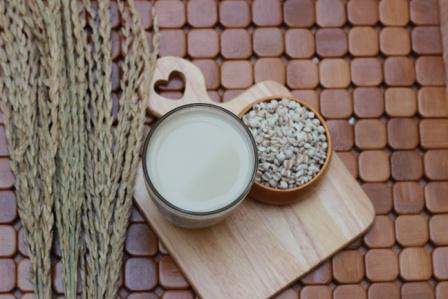
Table of Contents
Vernacular names
Names in different languages:
Hindi name- Samkru
English name- Job’s tear, Adlay millet, Coix Seed, Yi Yi Ren
Bengali name- Gurgur
Gujarati name- Kasi, Kasai
Kannada name- Ashru beeja
Malayalam name- Kattugotampu
Manipuri name- Chaning
Marathi- Ran maka
Tamil name- Kattu kundumani
Telugu name- Adavi guruginja
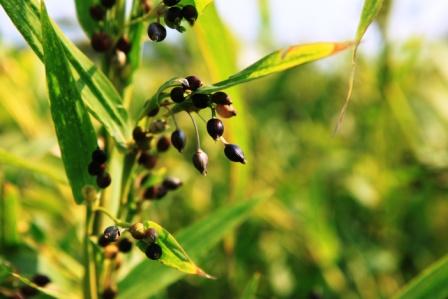
Medicinal qualities
Medicinal properties of Gavedhuka – Job’s tears:
Rasa (Taste) – Katu (Pungent)
Guna (Qualities) – Laghu (Light for digestion), Ruksha (Dry in nature)
Vipaka – Katu (Undergoes pungent taste after digestion)
Veerya (Potency) – Ushna (Hot)
Karma (Actions) –Kapha pitta hara (reduces vitiated kapha and pitta dosha)
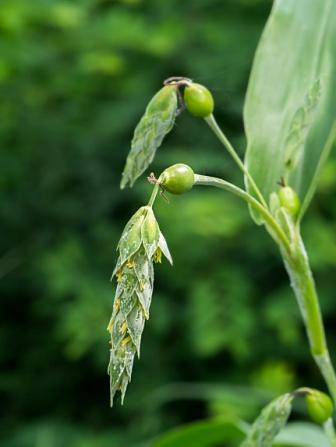
Part used, dosage, chemistry
Part used- Grain, Root and Leaf
Dosage-
Decoction- 50 to 60 ml
Root powder- 5 to 6 g
Chemical composition of Coix lacryma-jobi:
The seeds contain trans-ferulyl stigmastanol and trans-ferulyl campestanol, which form part of an ovulation inducing drug. Seeds contain coixenolides, a mixed ester of palmitoleic and vaccenic acids, which is an anticancer agent.
Uses, remedies
Uses of Adlay millet:
- The root of Gavedhuka is made into decoction and given in a dose of 50 ml to treat menstrual disorders like excessive bleeding, irregular menstruation etc.
- Powder of Coix lacryma is given in a dose of 5-6 g mixed with lime juice and honey to reduce weight or obesity.
- Powder of Gavedhuka roots should be left mixed overnight in 6 times water. This should be filtered and consumed in the morning to treat nausea and vomiting.
- The fresh juice from the stem of the plant is used as eye drops to relieve burning sensation in the eyes.
- In some parts of Asia, the decoction from the grains of Coix lacryma is used like herbal tea which is beneficial in treating cough and dyspnoea.
- The grain of gavedhuka is mixed with rice grain and water, fermented in a mud pot and later used as an alcoholic drink.
- Gruel prepared with gavedhuka is administered along with honey to lose weight. (Charaka Samhita, Sutrasthana 2nd chapter, 25th verse)
- Food prepared with Gavedhuka is best to lose weight (Gavedhuka annam karshaneeyanam – Charaka Sutrasthana 25th chapter, 40th verse)
- For Pitta type of vomiting, associated with severe burning sensation, migrain, gastritis, water added with the powder of chanaka (Bengal gram) or Gavedhuka- root or Guduchi – Tinospora cordifolia and kept to overnight can be given to the patient. – Charaka Chikitsa Sthana 20/31
- Meat soup prepared with decoction of gavedhuka, along with Gokshura, Vasa, Bala, Punarnava etc is used for treating dysruia caused by vitiated semen. (Charaka Chikitsa sthana 26/69)
Sanskrit Shloka
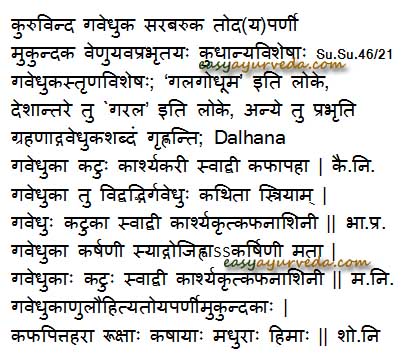
Gavedhuka uses as per Ayurveda:
Karshani – causes weight loss, useful in obesity
Karshyakari – useful in weight loss
Kaphahara – balances Kapha, useful in productive cough, asthma, bronchitis, chest congestion
Rooksha – dry
Kashaya – astringent
Madhura – sweet
Hima – coolant
Adverse effect: No adverse effect is seen or reported after the normal use of Gavedhuka
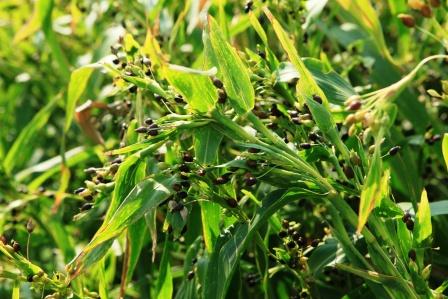
Interaction with medicines, supplements
Can this be used while taking Homeopathic medicine?
Yes. This product does not react with homeopathic medicine.
Can
this medicine be continued while taking supplements like multivitamin tablets,
Omega 3 fatty acids etc?
Yes. Generally, this product goes well with most
of the dietary supplements. However, if you are taking more than one product
per day, please consult your doctor for an opinion.
With western
medicines
Seek your
doctor’s advice if you are taking this product along with other western
(allopathic / modern) medicines. Some Ayurvedic herbs can interact with modern
medicine.
If both Ayurvedic and allopathic medicines are advised together, then it is
best to take Allopathic medicine first, wait for 30 minutes and then take the
Ayurvedic medicine.
Ayurvedic medicines, Research
Ayurvedic medicine containing Job’s tears:
Vishnu taila: It is an herbal oil, used in the treatment of bone fractures, male infertility, lack of strength in sense organs, facial palsy etc.
Research articles related to Coix lacryma-jobi:
Anti- cancer activity: The total of 330 extracts included 150 methanol extracts and 180 hexane extracts were investigated for anti-proliferative activity on human colon adenocarcinoma cell line (HT-29) by the sulforhodamine B (SRB) assay. The extracts which gave high anti-proliferative activity were tested for apoptotic activity by acridine orange and ethidium bromide double staining and anti-oxidative activities including free radical scavenging and lipid peroxidation inhibition activities. This study has demonstrated the anti-colorectal cancer potential of the M-HTBL-R2 and M-HTBL-N1 extracts.
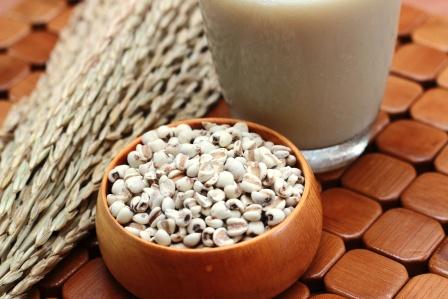
Classical categorization
Bhavaprakasha – Dhanya varga
Madanapala Nighantu – Dhanya varga
Kaiyyadeva Nighantu – Dhanya varga
Shodala Nighantu -Trina dhanya varga
Scientific classification
Kingdom: Plantae
Order: Poales
Family: Poaceae
Subfamily: Panicoideae
Tribe: Andropogoneae
Genus: Coix
Species: C. lacryma-jobi
Morphology
Morphology of Coix lacryma jobi:
Gavedhuka is a coarse, tall grain bearing annual herb. The stem is erect, branched, rather coarse, and stout, and 1-2 m high. The leaves are 10-40 cm long, 2.5-4 cm wide, with the base broad and cordate. The spikes are 6-10 cm long, erect and peduncled. The male spikelets are about 8 mm long. The capsules (fruits), enclosing the female flowers and the grains, are hard, bony, white or nearly black, shining, ovoid, about 8 mm long. The grain remains inside the involucre. The involucre is initially green, gradually becomes black and then becomes gray to white. The edible fruit have commercial value and consumed as grain in some parts of Asia. The plant is wildly seen and cultivated in Asia, both for its commercial value and as source of food grain. The wilder variety has hard shelled pseudocarps which is hard, white colored, oval in shape and used as beads in making necklace and other ornaments. The cultivated variety has a soft shell and used as both grain and medicine. The wild variety is seen in swampy area or in hot climates with moist soil.
Sanskrit synonyms
Ashrubeeja- The seeds resemble that of a tear drop
Kuruvinda, Sarabaruka, Todaparni, Toyaparni, Galagodhuma, Garala
Gojihva, Varshika, Varshani, Gavedhu, Gavedu, Gaveduka, Gaveduk, Gavedhuk
Author: Dr.B.K.Prashanth M.D (Ayu), Ph.D
E mail: drprashanthbk@gmail.com
Click to consult Dr Prashanth BK









4 comments on “Adlay millet Coix lacryma-jobi: Benefits, Research, Remedies”
Gary Y.
If you wish to include references in Caraka, some are Su 2.25, Su 25, Su 27.16–18, Ci 20.26–33, and Ci 26.52–65. I’m unsure if you are tracking anti-HIV activity of various foods and herbs. For gaveduka, one is Screening of traditional medicines for their inhibitory activity against HIV-1 protease. As bacteria and viruses such as tb, malaria, zika, ebola, dengue, and HIV are becoming more pervasive, and many foods and herbs have various antibiotic and antiviral properties, perhaps worth doing.
Dr J V Hebbar MD(Ayu)
Thanks. Updated with the said references.
Gary
As you know, it is widely grown in east Asia and easily found from such sources. Is there any Indian variety commercially grown and available?
Dr J V Hebbar MD(Ayu)
It is available in amazon India website. I am unware of any Indian version of it.